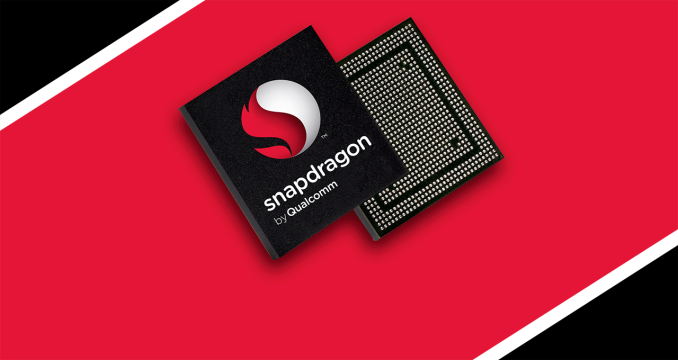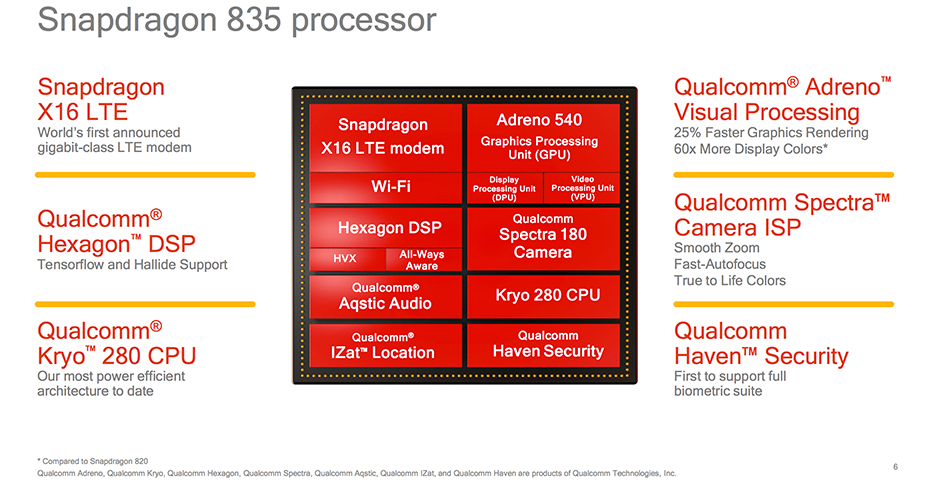The Qualcomm Snapdragon 835 Performance Preview
by Matt Humrick & Ryan Smith on March 22, 2017 4:30 AM EST- Posted in
- Smartphones
- Snapdragon
- Qualcomm
- Mobile
- SoCs
- Snapdragon 835
- Kryo

The Snapdragon 820 SoC was a significant milestone on Qualcomm’s roadmap. It was a solid improvement over the 808/810, delivering higher performance and efficiency, and became a commercial success, finding its way into the majority of flagship phones last year. More importantly, it heralded Qualcomm’s vision for mobile devices: heterogeneous computing. This meant new hardware—a much improved Hexagon 680 DSP that added single instruction, multiple data (SIMD) Hexagon Vector Extensions (HVX); Qualcomm’s first fully-custom 64-bit CPU core, Kryo, which focused on improving floating-point IPC; and an updated Adreno GPU with strong ALU performance—for enabling new software technologies and user experiences—artificial intelligence for smarter personal assistants, machine learning for object recognition, computational photography for better image and video quality, and new AR/VR experiences.
Snapdragon 835—now a part of Qualcomm’s Snapdragon Mobile Platform that includes all of the company’s mobile hardware and software—is an evolutionary product that builds on this vision. The greater than 3 billion transistor SoC is the first to use Samsung’s 10nm "10LPE" FinFET process, which reduces overall package size by 35% relative to Snapdragon 820. The new SoC’s CPU transplant and X16 LTE modem, which tops out at 1Gbps (Category 16) on the downlink, are the biggest changes, but most of the other blocks within the SoC have received at least minor updates too. For detailed information about all the changes and new features, you can read our Snapdragon 835 launch article.
| Qualcomm Snapdragon SoCs: Three Generations | |||
| SoC | Snapdragon 835 (MSM8998) |
Snapdragon 820 / 821 (MSM8996 / MSM8996 Pro) |
Snapdragon 810 (MSM8994) |
| CPU | 4x Kryo 280 Performance @ 2.45GHz 4x Kryo 280 Efficiency @ 1.90GHz |
2x Kryo @ 2.15GHz / 2.34GHz 2x Kryo @ 1.59GHz / 2.19GHz |
4x Cortex-A57 @ 2.00GHz 4x Cortex-A53 @ 1.50GHz |
| GPU | Adreno 540 @ 710MHz ? | Adreno 530 @ 624MHz / 653MHz | Adreno 430 @ 630MHz |
| Memory | 2x 32-bit @ 1866MHz LPDDR4x 29.9GB/s |
2x 32-bit @ 1866MHz LPDDR4 29.9GB/s |
2x 32-bit @ 1600MHz LPDDR4 25.6GB/s |
| ISP/Camera | Dual 14-bit Spectra 180 ISP 1x 32MP or 2x 16MP |
Dual 14-bit Spectra ISP 1x 25MP or 2x 13MP |
Dual 14-bit ISP 1x 21MP |
| Encode/Decode | 2160p30 (2160p60 decode), 1080p120 H.264 & H.265 |
2160p30 (2160p60 decode), 1080p120 H.264 & H.265 |
2160p30 (2160p60 decode), 1080p120 H.264 & H.265 |
| Integrated Modem | Snapdragon X16 LTE (Category 16/13) DL = 1000Mbps 3x20MHz CA, 256-QAM UL = 150Mbps 2x20MHz CA, 64-QAM |
Snapdragon X12 LTE (Category 12/13) DL = 600Mbps 3x20MHz CA, 256-QAM UL = 150Mbps 2x20MHz CA, 64-QAM |
Snapdragon X10 LTE (Category 9) DL = 450Mbps 3x20MHz CA, 64-QAM UL = 50Mbps 1x20MHz CA, 16-QAM |
| Mfc. Process | 10nm LPE | 14nm LPP | 20nm SoC |
In what has become an annual tradition going all the way back to Snapdragon 800, Qualcomm invited the media to its headquarters in San Diego for some feature demonstrations and limited testing using the company's Mobile Development Platform (MDP) devices. These are fully functional tablets or smartphones in a slightly oversized, utilitarian chassis used for hardware testing and software development. The MDP for Snapdragon 810 took the form of a tablet, while Snapdragon 820 came inside a large smartphone with a 6.2-inch display. This downsizing trend continues for Snapdragon 835, whose MDP/S is a smartphone with 6GB of RAM, a 5.5-inch 2560x1440 display, and a small 2850 mAh battery. The use of a smaller chassis is encouraging, because it has less mass and surface area to absorb and dissipate heat. This suggests a lower TDP for the 835, but we'll need to measure power consumption to be sure.
Because we only had a limited time for testing, we focused on running some basic CPU, GPU, and memory performance tests. Keep in mind that we were testing prototype hardware running pre-production software that resulted in a few hiccups. The condensed testing period also forced us to stray slightly from our usual testing methodology. Therefore, these numbers should be viewed as preliminary and could change by the time retail units begin shipping.












128 Comments
View All Comments
Andrei Frumusanu - Wednesday, March 22, 2017 - link
What a load of nonsense. GB uses all cores efficiently and it scales just perfectly. You just have a severe misunderstanding of both of the SoC and how the GB score is composed. Calling it worthless just because you don't understand it just makes you look stupid.And just for the sake of education:
Just because there's 8 cores and the strongest SC score is 2K doesn't mean you can just take some multiplier number to get to the MC score. First of all 20% of both the SC and MC scores are composed of the memory performance which simply doesn't scale much if at all between SC and MC scenarios.
If you look at the integer and floating point sub-scores you see that they're pretty much as you expect. When they're not, it's because the SoC's top frequency is only valid for single-core loads and drops to a lower frequency when using more of them, something that the S835 seems to do.
MrSpadge - Wednesday, March 22, 2017 - link
Furthermore MT may run into bottlenecks not present in ST: cache sizes, memory bandwidth, internal busses and maybe more.joms_us - Wednesday, March 22, 2017 - link
Nonsense, here is a task that 8 people can do if they all work together but only one is doing it 100%, the 2nd person 50-75% and the rest just 5-10% so they ended up finishing only half of it. That's how GB distributes load because of its pathetic threading and tasks distribution. Cinebench does it perfectly by distributing the rendering tasks in each core separately.You cannot say one SoC is weaker than another because GB is not maximizing its potential. Each core after then 2nd is just contributing about 500 points because they were useless throughout the testing.
joms_us - Wednesday, March 22, 2017 - link
And FWIW, that 2K score is just from efficiency core i.e Core 0. That's the default core where GB always runs the Single Core test.Andrei Frumusanu - Wednesday, March 22, 2017 - link
> And FWIW, that 2K score is just from efficiency core i.e Core 0. That's the default core where GB always runs the Single Core test.lol. You have absolutely no clue of what you're talking about.
Lord-Bryan - Wednesday, March 22, 2017 - link
Nah, the 2k is from the high performance core, geekbench can't just schedule a task to a particular core, that's the job of the scheduler in the the os. The highest performance core is always used to run large single threaded load.Andrei Frumusanu - Wednesday, March 22, 2017 - link
> Nonsense, here is a task that 8 people can do if they all work together but only one is doing it 100%, the 2nd person 50-75% and the rest just 5-10% so they ended up finishing only half of it. That's how GB distributes load because of its pathetic threading and tasks distribution.Also lots blablabla: http://i.imgur.com/PaLP1xw.png
ah06 - Wednesday, March 22, 2017 - link
Can you guys do a "What Ifs" short post on the expected changes if Apple went with an 8 core A11 or if Exynos/Snapdragon next iterations would score 3500 on Geekbench. What changes would we see where?joms_us - Thursday, March 23, 2017 - link
Since you are good at it, why don't you log the freq and usage of GB in 5 runs and show us which Cores are being used heavily. Stop logging each run at around 25% and another set at 100%. And if you don't mind, what is the name of that usage app you've shown in the image? TIAAndrei Frumusanu - Thursday, March 23, 2017 - link
They're all at maximum frequency and 100% always when the workloads are kicking in. Stop wasting people's time with your nonsense claims. I proved my claims, your turn to prove yours. You can use Trepn.